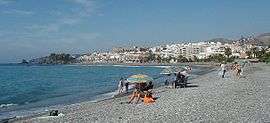Costa Tropical
| Costa Tropical | |
|---|---|
| Comarca | |
|
Landscape of the Costa Tropical near Salobreña. | |
 Location of the Costa Tropical in Andalusia | |
| Country | Spain |
| Region | Andalusia |
| Area | |
| • Total | 786.88 km2 (303.82 sq mi) |
| Population (2013) | |
| • Total | 125,746 |
| • Density | 160/km2 (410/sq mi) |

Costa Tropical (Spanish pronunciation: [ˈkosta tɾopiˈkal], "Tropical Coast") is a comarca in southern Spain, corresponding to the Mediterranean coastline of the province of Granada, Andalusia. It is also but less frequently called the Costa de Granada or Costa Granadina. It is crossed by the N-340 coastal highway that runs southwest-northeast along Spain’s Mediterranean coast, to the border with France. Within the last 4 years the A7 has been extended from Nerja in the Malaga province to the Taramay district to the east of Almuñécar. Construction is ongoing to link the A7 motorway to the A44 motorway which heads north from Motril on the coast to the city of Granada. This connection should be complete before April 2012 according to the Spanish Ministry of Development. Originally the whole section of A7 motorway up to Carchuna was due to be completed by early 2011 but the motorway has been besieged by delays due to technical difficulties and the Torrecuevas bridge collapse on 7 November 2005, when six workers died.
Geography
The Costa Tropical is made up mostly of agricultural zones and small resort towns and villages. What makes the Costa Tropical unique in comparison to the rest of the Spanish coast is that the mountains of the Sierra Nevada range fall to the very edge of the Mediterranean Sea on the rugged coastline. Except for la vega de Motril, there are no flat areas for large urban sprawl, unlike the Costa del Sol in the Málaga province.[1]
Climate
The area east of Málaga is less dry and more lush than the surrounding areas. This is because the Sierra Nevada mountain range that serves as a backdrop to the Costa Tropical catches more rain and thus supplies the area with abundant irrigation. This same mountain backdrop provides a shelter from northerlies and creates a pleasant microclimate of very mild winters and mild summers compared to the interior of Spain, with temperature differences of 10 °C (18 °F) relative to the area on the other side of the mountains – so it could be 38 °C (100 °F) on a summer day in the city of Granada and only 28 °C (82 °F) on the Costa Tropical. In the winter, it can be snowing in Granada and 10 °C (50 °F) on the Costa Tropical.[2]
Municipalities
The main towns of the Costa Tropical are Motril and Almuñécar. Motril is principally a manufacturing and agricultural center (horticulture, vegetables, tropical fruits and some sugar cane, although the last is declining). Motril also possesses a small seaport. Almuñécar is primarily a resort town and agricultural center (tropical fruits), with the summer-time vacation population more than tripling the town’s population. Like the rest of the Spanish coast, it recently underwent a housing and construction boom with some environmental degradation. This housing boom was not as severe as on other parts of the Spanish coastline due to the townships of Almunecar and La Herradura being unable to agree the terms of their new Urban plan (PGOU) with the Junta de Andalucia since 2002.
- Albondón
- Albuñol
- La Rábita
- Almuñécar
- La Herradura
- Velilla-Taramay
- Gualchos
- Castell de Ferro
- Ítrabo
- Jete
- Lentegí
- Los Guájares
- Lújar
- Molvízar
- Motril
- El Varadero
- Torrenueva
- Carchuna
- Calahonda
- Otívar
- Polopos
- La Mamola
- Castillo de Baños
- La Guapa
- Haza del Trigo
- Rubite
- Salobreña
- Sorvilán
- Vélez de Benaudalla
Points of interest
The Costa Tropical has many historical sights, including prehistoric cave paintings in nearby Nerja; many Roman ruins including roads, bridges, buildings, fish salting factories, and irrigation systems used to this day; and abundant remains of the many-centuries domination of the region by the Arab conquerors. In fact, Almuñécar served as the entry point to Iberia and establishment of a power base for Abd ar-Rahman I in 755, who came from Damascus and was the founder of an independent Muslim dynasty that ruled the greater part of the Iberian Peninsula for nearly three centuries thereafter.
See also
References
External links
 Media related to Costa Tropical at Wikimedia Commons
Media related to Costa Tropical at Wikimedia Commons- Costa Tropical News - English magazine and news website for the region
- Seaside Gazette - English magazine and news website for Costa Tropical, Lecrin Valley and Alpujarras
- Relocation information about the Costa Tropical
Coordinates: 36°45′N 3°36′W / 36.750°N 3.600°W
